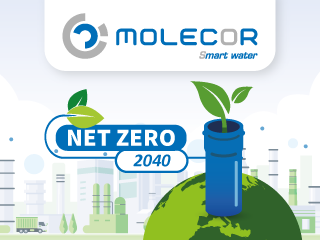
At Molecor we are continuing to push ahead with our commitment to sustainability, in this specific case focusing on the environment by completing our climate risk assessment. The aim of this initiative is to identify and mitigate the potential impacts of climate change on our operations and supply chain, placing us at the forefront of the plastics industry by integrating climate risk management into our business strategy, thus demonstrating our responsibility to the environment and our commitment to a sustainable future.
When climate challenges require a two-pronged analysis
In anticipation of the climate reporting requirement set out in the new Corporate Sustainability Reporting Directive (CSRD), and to understand the impact that climate change will have on our activities, Molecor has put in place a set of measures within our Strategic Sustainability Plan to make further progress in this area and fulfil our Net Zero 2040 ambition, taking a significant step forward by carrying out a climate risk assessment.
Among other initiatives, this Climate Risk Assessment is based on the recommendations of the TCFD (Task Force on Climate Related Financial Disclosures), the criteria for adapting to the European Taxonomy and the European Climate Reporting Standard (ESRS E1), with a view to meeting the objectives of the Paris Agreement in relation to cutting emissions in order to curb climate change and achieve climate neutrality by 2050. This study covers two key aspects: a Physical Climate Risk Assessment and a Climate Transition Risk and Opportunity Assessment, in which both physical and transition risks and opportunities (IROs) have been identified, assessed and their associated economic impact has been quantified for the 2030, 2040 and 2050 time horizons.
Firstly, the Physical Climate Risk Assessment allows us to evaluate the direct impacts of climate change on all our operations, including extreme weather events, changes in the availability of raw materials and the impact on infrastructure andlogistics, and to identify and mitigate risks that may affect production, our supply chain and the security of our facilities.
Meanwhile, the Climate Transition Risk and Opportunity Assessment focuses on the risks and opportunities associated with the transition to a low-carbon economy, such as changes in climate policy and regulations, shifts in demand for sustainable products and services, and technological advances in renewable energy and energy efficiency, as well as identifying the various opportunities to innovate and develop sustainable solutions that meet the needs of an evolving marketplace.
This analysis will allow us to anticipate the challenges of climate change and take proactive measures to ensure the resilience of our company and the continuity of our supply and our products.
The results show us the way forward
After conducting the study, in the case of physical risks, nine climate risks were identified, for which the level of exposure and vulnerability of the company's assets was analysed, and the associated economic impact was quantified. There are four notable risks affecting the organisation's facilities in a number of ways: water stress, which emerged as the climate risk with the biggest impact on the company; heat waves, surface water flooding and ground movements. The other climate risks that were identified affect a smaller number of sites and their economic impact is expected to be low.
For the Transition Risk Assessment, in addition to the temporary scenarios listed above, two additional scenarios were also considered in the analysis: fulfilment of the Paris Agreement and continuation of current climate policies. Regulatory, market, reputational and technology risks, and market, product, resource and energy efficiency and resilience opportunities were identified.
The assessment also yielded positive results, revealing up to ten climate opportunities that will allow us to strengthen our market position. Energy optimisation, resource efficiency and resilient procurement are just some of the areas where the company can innovate and lead the way towards a more sustainable future.







